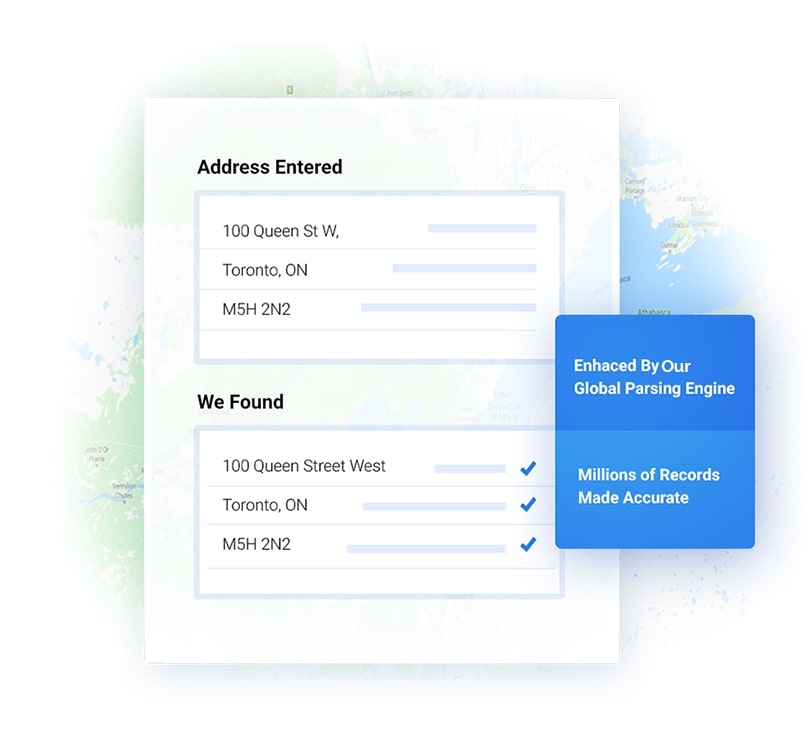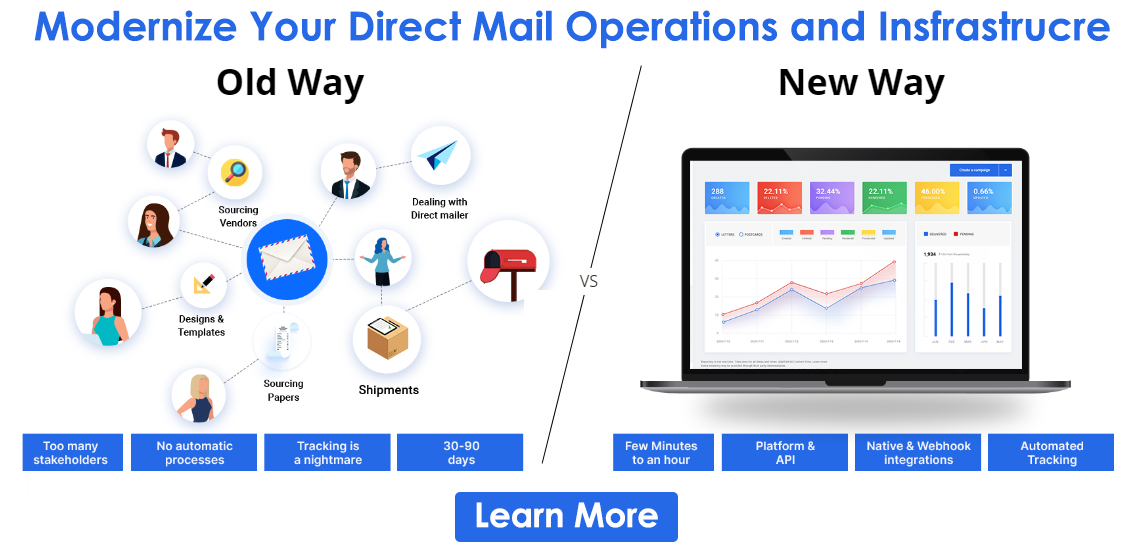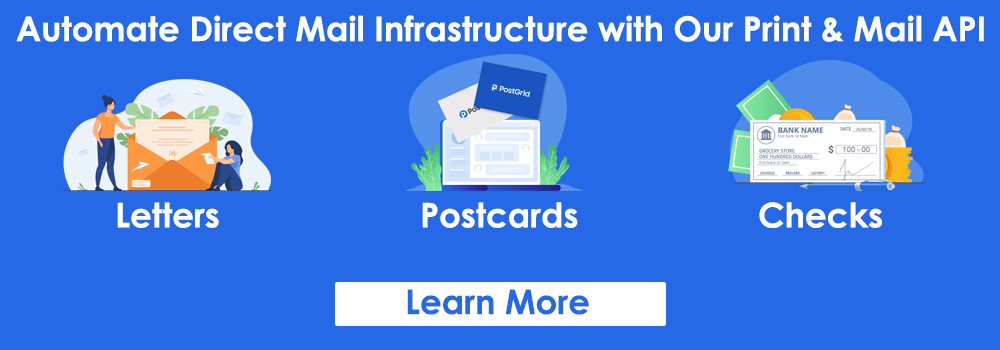Google Address Validation Vs PostGrid
What is Address Validation and Why Would You Need It?
Address validation is the process of converting inputs into standardized and verified addresses. There are two prime methods of address validation
- The addresses are captured and verified at the point-of-entry
- The database of a company is compared with the data of a reference source for parsing, standardizing, validating, formatting, verifying, and enhancing accordingly.

The difference between a satisfied and a lost customer is the user experience—that your company provides. From the UX point of view, brands need to constantly find and incorporate new technologies. PosGrid’s address validation tool can help you deliver orders accurately, on-time, and by incurring low costs. It helps you to significantly save time, resources, and efforts. Our API facilitates effective business operations and communications.
- Completes the address verification and validation processes quickly
- Increases the credibility of your business by timely deliveries
- Optimizes your data by cleansing it regularly
- Prompts people to buy from your website and complete the checkout process
- Provides high-quality data in real-time
- Improves user experience for all your customers
Google Address Validation Vs PostGrid
Address Parsing and Standardization
Let us start with the very step of validating an address – parsing. Now, what exactly is address parsing? It simply means having an automated tool break down an address into specific components. Every part of the address is read and the tool determines the meaning of each part. Accordingly, it will feed in particular details into particular fields—like street name, city, and country. It can get tricky sometimes due to abbreviations or misspellings. Depending on the parsing style, a tool can return inaccurate results based on wrong inputs and formats. Hence, it is needed that an address validation tool also standardizes the addresses as per the postal requirements.
Moving ahead, let’s talk about Google address validation. Google’s API does not necessarily parse and standardize addresses. In fact, all the returned addresses will be in different formats. In case you are looking for standardized, consistent, mailable data—Google will not do it for you. Maps are a strong suit for Google. But formatting addresses as per the requirements is not exactly its job. Companies require parsed, standardized, and deliverable addresses, not pinpointed locations on a big map. Hence, Google address validation is not the best choice—when it comes to organizing addresses in your mailing list.
However, PostGrid parses and standardizes all entered addresses. Moreover, you don’t have to enter the complete address. Once your user starts typing, the entire address will be automatically completed, parsed, and standardized – all at once in just seconds. Using our scalable API, you can get millions of addresses mail-ready.
Address Verification
Address verification or validation is when the entered addresses are checked against the database of the USPS or any other trusted sources. It is done to confirm whether the addresses are shippable. If the address is marked “valid”, it means that it exists and can be delivered on. Otherwise, the address will be stated as “invalid” suggesting that the address either doesn’t exist or is wrongly entered. All valid addresses are real, but it does not mean that all invalid addresses are unreal. They might be marked as invalid because of the format making them undeliverable. Owing to these reasons, parsing and standardization are both required initially. Proper address validation can happen only after these two steps. Google does not provide these initial steps with its address validation API. Therefore, it does not provide proper address validation. It may show a real address as invalid, and an unreal one as valid—based on the guesswork of its API. Users may also notice that the returned addresses are sometimes completely different from the inputted one, which happens due to the inability of Google’s API to first standardize and then validate.
PostGrid’s address validation API will help you to easily and quickly verify addresses in the most precise manner. It undergoes all the initial stages of validation and finally returns searches that are never wrong – in seconds. You can rely on our API to build mailing lists, cleanse your database, and make informed decisions with the help of this information. Also, you can use our API for your websites and make checkouts easier for your users, hence increasing sales and conversions.
Deliverability
Google address validation is basically good with mapping services. It will always show a location on the map according to the keystrokes entered. However, due to its inability to validate addresses—it is never able to confirm whether an address is mailable. Google creates a lot of confusion among its users. Primarily, it uses geolocation to pinpoint places on the map and provide directions to those places. It can absolutely give directions to an address that is not deliverable. Also, note that their addresses are not verified by trusted sources. Most of the data is collected through crowdsourcing. Google address validation simply takes the inputs into account and shows the closest possible location, obtained by geocoding. The returned address may or may not be deliverable. Businesses will not want to send shipments to addresses that aren’t deliverable. Hence, you will always need an address validation API that can determine whether an address is just a physical location, or can also be used for mailing.
PostGrid’s address validation API combines the database of the USPS and other trusted sources to determine whether an address is mailable. The returned response will consist of a DPV (Delivery Point Validation) code. There are 4 codes from 1-4. The code – DPV 1 indicates that the address is perfectly deliverable. The other three codes suggest that there are incorrect or missing inputs. Unlike Google, PostGrid does not return ambiguous results owing to possibilities and guesses.
For example, your customer entered an address – 740 Sunshine Street, Brooklyn, New York 11215. In reality, there are no houses or buildings on Sunshine street. Hence, the address is undeliverable. The user entered an incorrect street name. Google will not tell you these facts, but fortunately—PostGrid will. Google address validation will pinpoint the address on the map and you are likely to believe that house number 740 is right there on that street.
Data Quality and User Experience
Companies know the value of good mailing lists and high-quality data. It is truly the key to the success of a business. Firms have separate teams for data entry and updations. You might think that Google uses high-quality and up-to-date data to return address suggestions, but this theory is flawed. The addresses that Google uses in its address validation API are not updated all the time. Sometimes, the addresses are years old and waiting to be changed by a volunteer. Google does not make use of NCOA (National Change of Address) to update their database, missing millions of changes every year. Rather, it will show you the addresses based on the last updated information—which highly puts data quality at risk. When you incorporate Google address validation API in your address forms, there is a good chance that your customers will be frustrated with the wrong results, and will either manually correct it or mistakenly select the wrong address. It can have serious impacts on your deliveries, customer experiences, and conversions.
PostGrid, on the other hand, makes sure that all the addresses that are entered into a CRM, registration form, or checkout page are parsed, validated, verified, and enhanced. It also facilitates data cleansing to enhance the quality of your entire database from time-to-time. By using PostGrid’s address validation, you can reduce cart abandonment on your website and provide an exceptional user experience to your customers. Our API always autocompletes and returns verified and updated addresses. Incorporating type-ahead address validation on your websites enables you to reduce checkout times and allows users to fill in their correct details quickly. Our tool is predictive, flexible, accurate, and has the ability to validate millions of addresses at the same time. You can also add location filters and segment your data easily.
PostGrid’s API also allows the entry of single-line addresses, wherein only a single line field is shown on the website to enter the entire address. This type of address lookup is a more user-friendly and effective approach to adding an address validation tool to your website. In short, you can customize the address search bars on your websites—according to your needs.
Pricing
The free address validation services offered by Google allows you to search addresses in small quantities and only if you have a public website. If you are a company that needs to verify and validate addresses often, you will have to purchase their address validation API. Their prices are quite higher as compared to our competitive rates. Also, if you require any kind of technical assistance—it is either paid support or via a community Q&A forum. Google will not help you directly and for free of cost.
Until the year 2018, Google defined an address lookup as—the number of keystrokes entered. Basically, it charged fees according to the keystrokes, irrespective of whether a correct address is returned or not. Hence, a company would have to pay a lot, in order to look up even a few addresses. Moreover, the entries had to be made cautiously – so that credits are not wasted unnecessarily. Later, their definition of a lookup was changed and they started charging only for correctly verified addresses. But wait, you still don’t know if they are correct. Summing up, Google’s address validation services are costly and inefficient in terms of accuracy and deliverability—which kills the purpose of using them. An inefficient address validation solution can cost you a lot owing to various misplaced and delayed deliveries.
On the opposite side, PostGrid’s address validation will cost you much less than that of Google’s API. Additionally, you will have access to a lot more features and a 24×7 support system. Our high-tech features are designed in a way to validate every address precisely. PostGrid’s solutions are curated for you, to enter and validate large volumes of addresses quickly and accurately, and at highly competitive prices.
Secondary Internal Unit Designators
As we already know, Google makes use of geolocation to return an address. It will return the coordinates and show you the address on a map. It will also tell you how to get there. But the one important thing that Google’s API has no idea about is—a secondary address unit. Its address validation API has nothing to do with the fact that buildings have multiple storeys and units. It will show you the address to the outer building, but will not tell you where exactly the shipment has to be dropped off. Some buildings have hundreds of internal units—it will be so difficult to identify and deliver at the right address if an internal unit number is not mentioned at all. Google’s API is missing records for millions of units in the US addresses. As a result, the process of address validation remains partially automated, since the unit numbers are required to be manually entered by the users. Sometimes, they might as well forget to enter their apartment numbers, which will lead to delayed or returned orders.
PostGrid allows you to enter and verify every detail of your address, even the floor and apartment numbers. Using our API, you can be assured that there will be a significant reduction in the number of lost mails. PostGrid’s address validation API consists of millions of deliverable addresses including apartment, suite, room, and floor numbers. All the addresses returned by it are always up-to-date and ready-to-ship. Our address searches are linked with the USPS and other trusted data sources to help you validate your addresses perfectly.
Fuzzy Matching
A good question to ask your address validation tool is whether it corrects typos, fills in missing details, and provides fuzzy matching? Google, sure does not. An address validation API is supposed to work in real-time and enrich all your addresses by filling in the missing details. Unfortunately, Google’s address validation API is not smart enough to find spelling errors in your addresses and make the necessary corrections.
PostGrid’s address validation solutions offer address corrections and fuzzy matching. It is able to identify typos quickly and correct them on the spot. Our API fills in every missing component of an address like country, city, zip code, street name, and apartment numbers. Completed databases can enable you to be more competitive in the market and carry out all your business operations smoothly. For instance, you have to conduct a direct mail campaign and your market size is 10,000. Supposedly, you do have 10,000 addresses on your mailing list. But, the addresses are of completely no use—if there are errors and missing details. Our API can process your entire mailing list at once, check and correct all spelling errors, missing characters, transposed letters, abbreviations, and spacing mistakes immediately. This step makes data entry user-friendly, effective, and simple.
Let’s take an example. You are supposed to ship an order to “792, Brickell Avenue, Cannonsburg, Pennsylvania – 15317”. Instead of Brickell, your customer enters Brickwell, while completing checkout. Now, what if there is really a place named Brickwell in Cannonsburg? Obviously, you will ship the order to this incorrect address. It will lead to wastage of time, packing materials, administration costs, and postal charges. Moreover, your customer will be dissatisfied, angry, and might leave a bad review. All this can be avoided using PostGrid’s address validation API that will readily make these corrections for you—combining fuzzy matching, geolocation, and validation.
Certified Addresses and Security
When it comes to getting certified addresses against your inputs, Google will fail you again. It is clear that Google relies on volunteers from across the globe to add and modify addresses or even remove wrong addresses from their system. These volunteers are not professionals in the field of data entry. Hence, the data entered by them is not certified and may not be correct. When you are running a business, it is sure that you will not want to rely on volunteers to verify and validate your addresses. Furthermore, what happens to all the addresses that the Google address validation API collects? You can never be sure about data privacy, as Google is constantly using their data to present results on their search engine. Every piece of information that Google has collected is stored and combined into search results, in some way or the other.

PostGrid’s address validation services make use of CASS and SERP verified addresses. It makes it easy for you to check the accuracy of an address validation software. CASS certifications are used to make sure that the address returned is not altogether a different address from the one you entered. Sometimes, an API that is not CASS compliant, takes your input and turns it into a completely different address. It prolongs the process and makes it tiresome to enter it again. PostGrid will always return addresses that are pertaining to your inputs, making it easy for you to get correctly validated addresses. Besides, our platform highly takes care of your data security. PostGrid complies with all data privacy laws like HIPAA, PIPEDA, and SOC-2.
Branding Labels
Google uses the label “Powered by Google” on all of its address validation tools. It will show up on your address search bar. This label is meant to inform your users that you have incorporated the Google address verification API on your website. It is not always that your users will appreciate the fact that you are using anonymous data from Google to validate their addresses. PostGrid allows you to remove its branding from your website if you wish to. It enables you to be unique and show your customers that you have your own database.
We know that brand reputation is the most important part of successfully running a business. It is built over years with consistent efforts and excellent services. You can not afford to lose credibility over dissatisfied customers. An accurate address validation API will help you gain the trust of your customers through quick address entries, easy checkouts, on-time deliveries, and an amazing after-sales support system.
PostGrid’s address verification and validation services can help you to reduce user frustrations over long and boring checkout processes. It will enable your users to gain an incredible shopping experience—which will ultimately show your brand’s image in a positive light. Companies can integrate our API with their CRM and validate all the addresses in their database in one go. Properly organized and accurate data helps marketers draft business strategies and plans confidently. They can also conduct market analysis by segmenting the data and targeting their audiences accordingly. The management will be able to make better decisions and choices on the basis of precise data.
Set-Up and Integration
Talking about technicalities, Google’s API is pretty difficult to set-up and get started with. They don’t have a proper list of easy instructions for you to implement. The support system is also not entirely reliable. In short, its interface is hard to understand, difficult to set-up, and not dependable. The integration part also requires a lot of coding and technical expertise.
On the contrary, PostGrid’s API is very easy to install. Our technical support team can help you at any time of the day if you face any difficulties. In this way, you can be up and running in just a couple of minutes. PostGrid integrates with your CRM and with a wide range of e-commerce platforms like Magento, Shopify, and Salesforce. You can easily integrate our API with your online stores, websites, or address forms on any other platform. With our API, you can add the address verification and address tool on nearly any platform—where you want to validate the entered addresses. PostGrid automatically performs all tasks of autocompleting, parsing, standardizing, validating, and verifying—at the point-of-entry and using search-ahead predictions. Our zero-code native and Zapier integrations will help you get the best out of your system and use it in the most productive way possible.
Businesses That Require Address Validation
It is smart to decide beforehand whether your company requires an address validator. You should also decide whether addresses are a crucial part of your business, and how will inaccurate addresses affect you. If it does affect your business, you will require an address validation tool.
By using an efficient address validation API—you can save a lot of time, effort, and resources that your staff is putting in. You can also save your company from a bad reputation by always keeping your customers happy and content. It can be easily pointed out that all companies from a small e-commerce firm to a large franchise, require address validation. They all have to make sure that their addresses are correct and valid for making deliveries.
A brand hugely depends on its data for finding new clients and carrying out their business. Hence, data entry and validated addresses are required at all stages, levels, and models of business.
Online Businesses
You might be selling anything from apparel to flowers on your website or through e-commerce platforms like Amazon. Under any scenario, you will definitely require an address validation and verification tool. A type-ahead verification incorporated on your address bars will help your customers quickly order something, enter their correct address, and checkout. Furthermore, it will help your staff send these orders at the right addresses—without manually editing, verifying, and correcting anything. For large-scale companies getting thousands of orders every day, it is nearly impossible to verify the addresses without an address validation tool.
Hotels
When you book a hotel or are looking for renting a place—the first thing to consider is the address. Users will first look up a place based on its location and will then book it accordingly. Hotels and rental home websites require address validation solutions so that the users can book rooms and houses easily through their website. Platforms that have such listings also widely use such services to provide a good user experience to their customers.
Finance Companies
Banks and other finance companies need to maintain loads of addresses on a daily basis, They keep enlarging their database regularly. For these operations to be conducted smoothly, and address validation system is used. It makes data entry simple, cost-effective, and quick for its employees. These financial institutions also use the address verification API on their websites to complete applications, provide loans, and run credit checks.
Delivery Vendors
Delivery vendors or third party logistics companies who take delivery contracts are also one of the prime users of address validation services. They deal with addresses every day. With an API like PostGrid, they are able to run a quick check on addresses before sending out people to deliver them. It saves them a lot of time and money, as they don’t have to re-deliver items or pay extra for them, due to any delays and misplaced parcels. They can easily deliver on-time and fulfill their contracts without any difficulties.
Print Publications
Brands that are in the field of print publications work on subscriptions and advertisements. They have to send out their magazines or other printed materials regularly to a large number of people. Hence, they always use an address validator on their sites so that subscribers can enter correct and verified addresses, right at the point-of-entry.
Gyms, Clubs, and Other Offline Businesses
Gyms don’t have to mail parcels regularly. So you might think that they don’t require an address validation tool. However, they do send out membership cards sometimes. Clubs too, send out newsletters and coupons to their members. The point is—every business will have to eventually mail something to their customers. Also, with the increasing online presence of offline companies, the number of websites is increasing every day. Even brands that work offline have a website where customers can enquire or book something – by entering their details.
Other Businesses
Even if the model of a business doesn’t require shipping orders, they still have to advertise their brand from time-to-time. If you are planning to conduct a direct mail marketing campaign, an address validation tool will help you get your mailing lists ready in minutes.
Wrapping Up
Google is extremely good at a lot of things. Its address validation API also does the basic jobs. PostGrid, on the other hand, does not merely complete a job. It will not show you incorrect, ambiguous, and undeliverable addresses just to complete a task. PostGrid’s address validation API is all about accuracy, perfectness, and speed—all blended and presented in the form of addresses that will help deliver mails on time, increase conversions, gain people’s trust, and ultimately help you to successfully operate your business.
Annoyed with returned shipments and incorrect data? Use PostGrid’s address verification API to standardize, validate, and verify millions of addresses in one go. Get started now.
The post Google Address Validation Vs PostGrid appeared first on PostGrid.
source https://www.postgrid.ca/google-address-validation/


Comments
Post a Comment